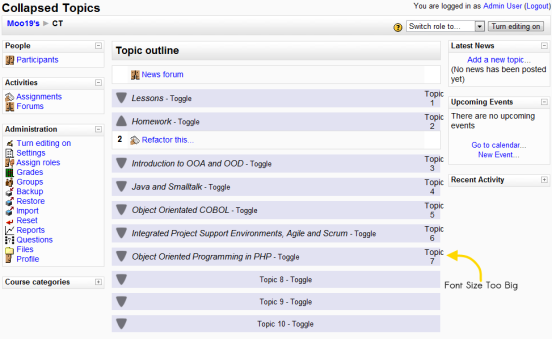Collapsed Topics course format
The Collapsed Topics course format is a contributed code module. The format is similar to the standard Topics format except that all topics (except '0') can be 'toggled' on and off. This reduces clutter in courses that have a large number of topics, lots of content in the topics or a combination of the two.
Usage
Selecting
To select the format, simply choose it from the list
of course formats in the course settings. To show / hide a topic just click on its toggle.
Toggle State
When refreshing the page, the state of the 'toggles' is remembered. This is on a per browser session per course basis for as long as the browser remains open.
Changing the look
Formatting
Most of the formatting is contained within the file 'topics_collapsed.css' which is fully commented to facilitate easy manipulation of specific elements. For example, if you found that in your particular web browser the 'Topic x ' text was too big...
Then you can add an addtional 'font-size:0.6em;' to the 'tr.cps td.cps_centre' class.
The Arrow
If you want to change the look and style of the arrow, simply change 'arrow_down.png' and 'arrow_up.png'.
FAQ
Q. How do I report an issue with Collapsed Topics? A. Raise an issue on Moodle Tracker or post a discussion on the Moodle Course Formats Forum
Q. Is Collapsed Topics Moodle 2.0 compatible? A. The latest version is but please use at your own risk. It does not have all of the desired changes to make it fully 2.0 compliant as I maintain it whilst Moodle 2.0 is still changing as development progresses.
Credits
Collapsed Topics has been developed by and is maintained by Gareth Barnard with invaluable input from:
- Anthony Borrow
- Frank Ralf, Matt Gibson, Howard Miller and Tim Hunt who commented on the Developer Forum
- Craig Grannell - Snub Communications who wrote the article 'Collapsed Tables' in .Net Magazine Issue 186
See also
- [Collapsed Topics is the Modules and plugins database page for downloads and more information on this module. There are versions for Moodle 1.8, 1.9 and 2.0.
- Discussions: please create or find a discussion topic in the Moodle Course Formats Forum
- Bugs can be reported on Moodle Tracker
- Collapsed Weeks course format is a similar contributed code module.



